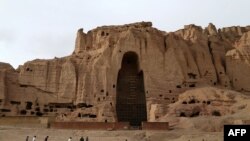For years, central Afghanistan's picturesque Bamiyan Valley was scarred by the image of the Buddhist statues destroyed by the Taliban in 2001.
But the opening of Afghanistan's first national park, Band-e Amir in 2009, as well as a recent spate of investments in tourism infrastructure, direct flights, a new museum and an international designation as Capital of Culture have put the mountainous region on the map for more positive reasons.
While the government in Kabul tackles the Taliban's annual spring offensive, provincial authorities in Bamiyan have been busy launching an offensive all of their own, albeit one of charm, to celebrate the province’s designation as the South Asian Association for Regional Cooperation (SAARC) Capital of Culture 2015. The new label has added prestige, according to local tourism officials, highlighting long-term efforts to strengthen tourism in the province.
Over the past five years, a total of $20 million has been invested into five luxury facilities and hotels in Bamiyan, which in addition to Bande Amir National Park boasts many Central Asian Buddhist temples and ruins as well as what are believed to be some of the oldest cave paintings in the world.
East Horizon Airlines, a domestic Afghan carrier, now operates two weekly scheduled flights from Kabul to Bamiyan. Small, 47seater Antonov planes depart Kabul on Mondays and Thursdays, with a one-way fare costing approximately 5,500 afghani ($91) and a flight time of about 30 minutes. The direct flight has made the 150kilometer trip from the Afghan capital more accessible to foreign and domestic visitors, as travel by road is plagued by kidnappings and insecurity.
Improved transport and hotel facilities are just part of the longer-term developments in the tourism sector. The planned Bamiyan Cultural Centre, according to a November
2014 UNESCO press statement, "will support artistic and cultural processes, using the institution as a platform to connect the public with Afghan cultural traditions and practices."
The Bamiyan Cultural Centre, the design of which was chosen through a competition in January, will be built on a 26,000-squaremeter plot facing the spot where two Buddha statues, destroyed by the Taliban in 2001, once stood. It will be financed by the Republic of Korea and jointly built by UNESCO and the Afghan government.
As part of Bamiyan's Capital of Culture designation, a number of events, fairs, and symposia will be held throughout the year, including the First International Fair for Culture and EcoTourism, a Silk Road festival, and Buddhism awareness events, as well as tours of heritage sites, performances by local artists, and special culinary nights.
During a scheduled visit in June, President Ghani is set to inaugurate both the cultural center and the year's Capital of Culture events.
Colonel Mohammad Ali Lakzai, the local police chief, is confident that many people -- most notably the president -- will be able to safely visit Bamiyan and enjoy the festivities. "Our security forces have been preparing for three months to avoid any potential security incidents," Lakzai said.
Fostering an image of stability
The number of tourists visiting the province has decreased in recent years, say local authorities. "Although there were no flights flying into Bamiyan at the time, in 2013 we still had more than 600 foreign tourists," says Ahmad Hussain Ahmadpur, head of the Provincial Department of Information and Culture in Bamiyan. "In 2014, this number decreased by almost half, but we hope that with improved security and facilities - and the availability of more flights into Bamiyan - the number of tourists will increase again."
"The instability on the roads leading to Bamiyan and the volatile security situation in the country prevents domestic tourists from coming, and this has caused our revenues to drop," says Abdullah Mahmodi, the manager of the Highland Hotel, one of the province's fivestar resorts recently built with government money.
Business leaders, however, say the SAARC spotlight on Bamiyan has already helped attract more visitors to the region. "With the start of the festivities, the number of visitors has increased," Uzra Lali, an artisan working in a market in Bamiyan City said. Bamiyan's artisans produce embroidered products, handwoven carpets, rugs, and lace items renowned countrywide. Many of these artisans are women, producing handicrafts made from animal fibers and tree bark.
Many of the artisans are excited about the opportunities afforded by this year's spotlight. "With the start of spring and the arrival of the SAARC festivities, the women producing handicrafts in this province are motivated to produce even finer and better products for customers," says Haleema Rezai, a local entrepreneur.
fg/as




